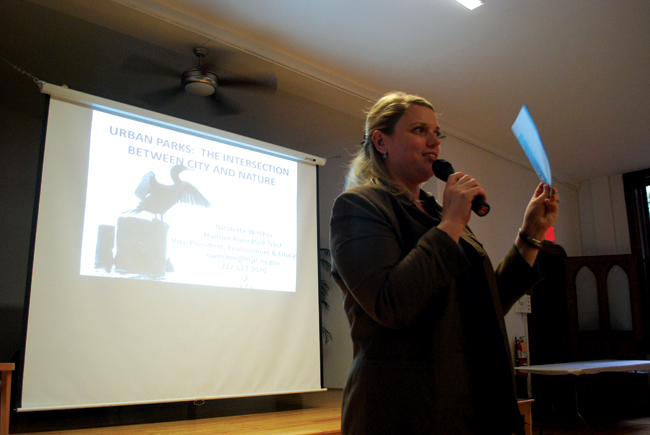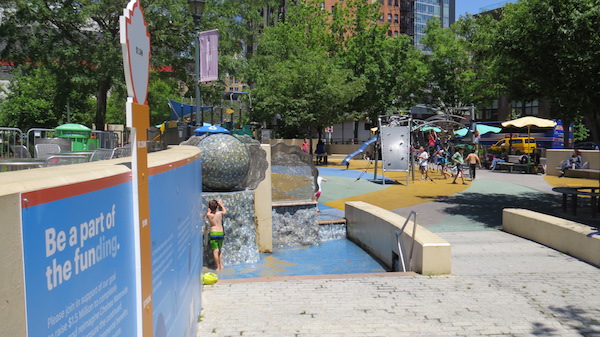
BY WINNIE McCROY | Nature’s power to invigorate and inspire, along with our stewardship of that resource, was the thematic river that ran through the annual meeting of Chelsea Waterside Park Association (CWPA), held on the evening of Wed., May 24, at St. Paul’s Church (315 W. 22nd St., btw. Eighth & Ninth Aves.).
“Urban parks are a critical intersection between nature and the city,” said keynote speaker Nicolette Witcher, who serves as both vice president and the head of environment and education for Hudson River Park Trust (HRPT). “They are so important,” she said of accessible green spaces. “I raised three children in Manhattan, and the playgrounds and dog runs are essential; they give us great joy and utility.”
Unlike the days of yore, when the monied elite would wisk their children to the country to commune with nature, today’s urban dwellers can find nature right where they live. This is in large part due to the efforts of the NYC Department of Parks & Recreation, and groups like the CWPA and the Friends of Hudson River Park (FoHRP), the nonprofit advocacy and fundraising arm of HRPT (which works in partnership with the city and state to operate and maintain Hudson River Park, a four-mile, 500-acre stretch along the Hudson River, from W. 59th St. to Battery Park; visit hudsonriverpark.org).
Witcher said it was critical that people interact with nature right where they live, be it via investigating nesting birds during nature walks, helping restore the oyster population in the river, or just breathing in the salt air while jogging along the Hudson River Park.
“Our way of connecting with nature is critical to our existance as a person, and our community as whole,” Witcher said. “Research tells us if we don’t have real, meaninful interactions with nature, we are not as likely to exhibit pro-environmental behaviors.”
“Nature also makes us more productive; a University of Michigan study shows that after just one hour in nature, memory and functioning improves by 20 percent,” she continued.”And nature heals us; hospital beds with windows overlooking trees show patients released sooner, and with less pain medication. Swedish studies show that joggers on a tree-lined path have much less anxiety and better mental health. And nature brings us together: tree plantings in urban communities breaks down barriers, sets aside arguments, and builds very strong communities.”
In order for people to value nature, said Witcher, it’s not enough for them to just spend time in the country. They need to interact with nature where they live. And that’s where the Hudson River Park comes in; by integrating nature into the city, they can help people feel more connected to the environment. By 2050, 60 percent of all people will live in urban areas, said Witcher. So now is the time to focus on preservation.
“Look at composting,” Witcher said. “It’s a simple little thing to put your organic trash in a different place than your regular garbage, and almost one-third of New York City’s garbage could be composted rather than barged or trucked out. Think of all that fuel used every day. All that garbage could just disappear, and instead become organic material in our city parks, so they would’t have to truck in tons of soil for their plants. It could have a huge impact, overnight.”
COMPOSTING COMES TO HUDSON RIVER PARK | Chelsea residents are about to experience a sea change when it comes to your trash. As of Tues., June 6, you can drop off food scraps to bins at the W. 14th St. Pier as part of the Hudson River Park Compost Program. And starting Wed., June 14 at 6 p.m. on Pier 66, you can be part of the solution by joining the HRPT Compost Committee. They are currently seeking compost facilitators to work alongside Park horticulturalists to maintain and process compost materials and record data. They’re also looking for compost ambassadors to do community outreach and education. Volunteers must be 16 years or older, and commit to a minimum of two hours a week.
As part of the compost outreach efforts, the HRPT is collaborating with a group of students from the University of Michigan to find ways to streamline the composting process, with the goal of getting more community members to participate.
“Our project fits within the city’s Zero Waste 2030 goal and their sustainability goal,” said Anita Lin. “We want to simplify the waste project, and work with schoolchildren to encourage parents to compost. We are looking to take a third of the waste that is compostable and funnel that into 1,400 pounds of compost to use for gardening by the end of 2018.”
Student Alexander Ho asked community members to complete a survey identifying things that motivated them to compost, as well as those things that made them hesitant to compost, be it odor, rodents, or lack of space.
“With your insights, we can develop different strategies to get people in the community to compost and have a better environment,” Ho noted.

PREPPING FOR PLAY AREA RENOVATIONS | Connie Fishman and Tony Simone — who serve, respecively, as FoHRP’s executive director and director of external affairs — arrived to share great news: thanks to contributions from elected officials and community members, FoHRP is within $100,000 of its funding goal to renovate the 15-year-old Chelsea Waterside Play Area (visit tinyurl.com/jwyvdkb to support fundraising efforts).
“We anticipate securing full funding by the end of June, at which point we will send the design out to bid, and start the renovations by September, to be finished by next summer so that kids have a new place to play by next year,” Fishman said
As the first water play park for children in the neighborhood, this area gets an intense amount of use on a daily basis. Fishman said that playground equipment generally only lasts about a decade before it wears out. This water park suffered a shorter life span due to plumbing problems resulting from children pouring buckets of water and sand down the drains.
“It was a real learning lesson,” Fishman recalled, “and when the playground committee began looking for their first project, they voted unanimously to fix this.”
Community members, parents and the CWPA were asked what they would do if they had a fresh start. The new design goals included imaginative play features, the water and sand area better orchestrated, better sight lines, comfort and shade for parents, and separate play areas for big and little children.
They worked with Michael Van Valkenburgh Associates, Inc., who created an ariel design of the new playground featuring a water play area for young kids and a larger climbing area for bigger kids. On the remnant wall of the previous playground, they will commemorate the names of those who donated $5,000 or more. Among these are NY State Assemblymember Dick Gottfried, who donated $500,00, and City Councilmember Corey Johnson, who donated $800,000.
“Corey is a huge supporter of the Hudson River Park, especially the Chelsea Waterside Park, and over the past few years has directed over $800,000 in discretionary money to renovate the play area,” said his representative Matt Green. “We are excited about working on the renovations and celebrating with you all when the park is finished. We are also excited about the June 6 kickoff of this new composting initiative at Hudson River Park. It would be terrific to get as many people as possible to participate.”
Simone also noted that FoHRP raises several million a year from mostly private funds for free education and environmental programs for kids in all five boros. This includes Big Hit Wednesday movies, Family Fridays, Hudson Riverflicks Sing-Along Specials, fishing, kayaking, sailing, and nature walks. All information is available in their new brochure, Hudson River Park Presents Summer of Fun 2017.
NEW WEBSITE, NEW BOARD | CWPA Co-Secretary Donathan Salkaln launched the group’s new website at cwpark.org, and spent time showing community members the parts of the site, including how the color-coded map corresponded to the calendar of events; for example, the purple color indicating the dog park could be used to correspond to a purple marker for a dog Halloween costume contest.
Salkaln envisioned the park as five little villages: the dog run, kids park, floral gardens, basketball courts, and soccer fields. He invited community members to help unite these areas by become writers and photographers for the site. Salkaln said he was inspired by the work of longtime community member Robert Trentlyon, who wrote a column on his proposed storm surge barriers for the website. He also noted that he’s been working with a representative at the Fulton Houses to encourage kids to begin posting news and photos about the activities at the basketball courts and soccer fields. There was also talk of a possible expansion of the dog park.
Finally, CWPA Treasurer Burt Lazarin took a few minutes to introduce the members running for their 2017 Executive Committee, some of who had been longtime fixtures in the community, and others who had moved to the neighborhood in the past decade.
“I encourage everyone to participate in our events and meetings, and to sit in on the board meetings,” said Lazarin. “We would like all the communities to come together, and all of these different people to be on the board. Right now it is not representative of all the people in Chelsea.”
Finding no objections to the proposed leadership committee, Lazarin closed the meeting, saying, “We have consensus. And I hope we will have some additional names the next time around.”

















